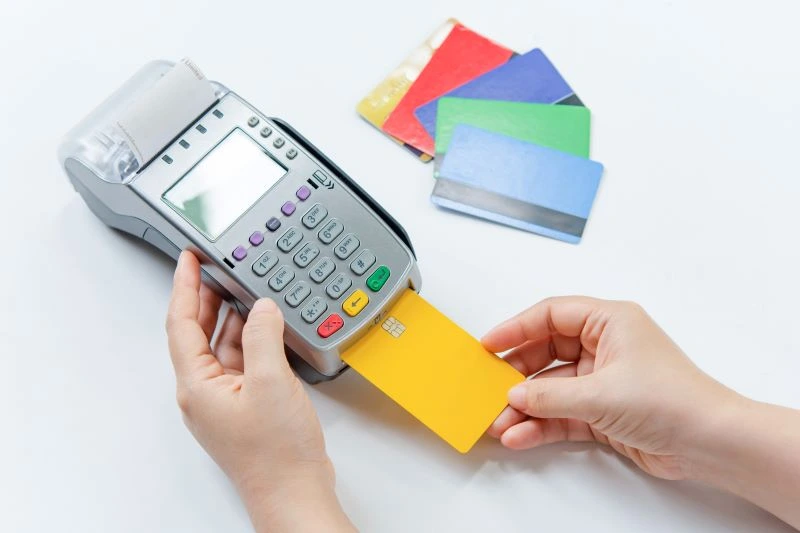If you’re running a business of any shape or size today, accepting credit card payments can make a huge difference in your customer satisfaction. Whether you run a small eCommerce store, a brick-and-mortar shop, or an online service company servicing B2B customers, offering the convenience of paying with a debit or credit card can significantly boost your sales and customer satisfaction. But since you landed on this article, you already knew that. What is less clear is how to navigate the complex landscape of payment processing. For most people, it’s a whole new world that can feel confusing and overwhelming. How do you get started? Stay tuned to find out.
With various options and technologies to choose from, you’re sure to find the perfect balance for your business. In this guide, we'll walk you through the ins and outs of credit card payment acceptance, from understanding the key concepts to choosing the right solutions for you and your customers. Let’s dive in.
Why Accepting Credit Card Payments is Crucial
There are a lot of businesses that still try to get away with only cash or check payments. However, accepting credit card payments is a fundamental necessity for businesses today.
-
Convenience: Credit and debit card payments have become the preferred method of payment for most people (likely yourself included). It’s easier to manage balances, you can purchase what you need without worrying if you have enough cash on hand to cover it, don’t have to wait for a check to clear, and can tap and go with ease. If you don’t accept debit or credit cards, there’s a good chance your customers will go elsewhere to find that convenience.
-
Broader customer base: Accepting credit card payments also opens the door to a broader customer base. Today, most of us expect the convenience and flexibility of card payments. So not having that option can feel like an unnecessary inconvenience, especially for those of us who no longer carry cash or checkbooks.
-
More reliable cash flow: Finally, accepting credit card payments often translates into faster and more reliable cash flow. With electronic payment processing, you can eliminate the delays, errors, and inefficiencies associated with handling physical cash or checks.
Steps to Start Accepting Credit Card Payments
So you know you need to accept cards, but how do you establish a credit card payment system in your business? Let's break it down into three steps:
1. Determine How You Will Accept Credit Cards
The first thing you’ll need to decide is whether you want to accept credit cards in-person, online, over the phone, or through a combination of these methods. Your answer to this question will largely depend on your business model and customer needs, so hopefully the answer to this is easy to come to.
Credit vs debit card transactions
Credit and debit cards serve as common means of payment, each with distinct features. When using a credit card, individuals essentially borrow money from the card issuer, accumulating a balance to be repaid later, subject to interest if not paid in full by the due date. On the other hand, debit cards directly withdraw funds from the linked bank account, limiting spending to the available balance.
2. Choose a Credit Card Processing Provider
Next, you’ll need to find and partner with a payment processor. To accept debit or credit card payments, you’ll need access to the payment networks (essentially a channel that connects you to the payment networks). This will give you access to moving money between your customers' bank accounts and your business bank account.
We recommend conducting some research on this front using sites like BBB.org and Merchant Maverick to help you understand each processor’s reputation. You’ll need one that ticks the boxes on things like business requirements, technology, growth potential (i.e., can your business scale with them), budget, competitive fees, and data security.
3. Implement Required Hardware and Software
Once you’ve chosen a credit card processing provider and set up your account, you’ll need to get the equipment set up in your business environment. They should ship you pre-programmed hardware (such as card readers or point-of-sale systems) if requested. Your provider will also help you connect to their software (payment gateways, virtual terminals, or eCommerce solutions), allowing you to process credit card payments effectively and securely.
How To Accept Credit Card Payments
Next, let’s chat about how you can accept payments at your business, whether they are in-person, online, mobile, or over the phone.
How to Take In-Person Payments
To take in-person credit card payments, begin by selecting an appropriate point-of-sale (POS) system or device and setting up a merchant account through your chosen payment processor.
As we touched on, they should send the hardware you’ve chosen, such as a card reader, and confirm it complies with PCI DSS security standards. They can then show you how it works.
Once you’re comfortable, train your staff to do the same:
- Operate the POS system
- Enter transaction details
- Process payments
- Issue refunds
- Issue receipts
- Reconcile batch totals
When complete, you’re ready to accept in-person payments.
How to Accept Credit Card Payments Online
It’s really difficult to run a business online without card payments, so if you’ve set your website up already, you’ve probably looked into a few options.
Most hosting companies/CMS systems will push you to their partnered vendor (for example, Shopify will push you to Shopify Payments or WooCommerce will push you toward PayPal or Stripe). But those aren’t the only options you have.
Instead, it’s important to understand your payment processor of choice’s integration compatibilities.
Here’s a bit more on that process:
First, you’ll set up your website. Then you’ll want to connect it to a payment gateway, so select a payment provider that is compatible with your gateway. Most payment processors have a “compatible integrations” page on their website to help you narrow it down. If you can’t find one, you can also contact the company and request information about their available integrations.
Note: “Integration” just means that their software is compatible with yours, meaning they have created a connection between the two to help them run smoothly together.
Finally, you’ll want to test it out and make sure everything flows correctly: from the initial payment to the post-payment confirmation emails to make sure everything flows smoothly.
How To Accept Mobile Credit Card Payments
If your business operates on the go, like a pop-up boutique, weekend stand at the farmer’s market, or house-to-house (like an electrician or contractor), mobile payments are essential.
To get started, you'll want to choose a reputable mobile payment processing solution, beginning with the payment processor that offers the technology and functionality you want. Once you've selected your provider, you'll need to create a merchant account to link your business to their app or gateway (they’ll be able to help you with this process).
Some apps function with a phone card reader attachment, others work with your phone’s NFC capabilities and allow you to tap and go. Regardless of your choice, there are great options to help you accept mobile payments to fit your business environment. Then, run a test transaction and make sure you understand how to receive a payment, print or email a receipt, issue a refund, etc. and you should be good to go.
How To Accept Credit Card Payments Over The Phone
Finally, another common form of payment comes from over-the-phone orders. If you engage with customers remotely, like taking deposits or offering a service, phone orders can be a great option.
To accept credit card payments over the phone you'll need a virtual terminal, which is a secure web-based application provided by your payment processor or merchant services provider. With a virtual terminal, you can manually enter the customer's credit card information (meaning physically typing it in), including the card number, expiration date, and security code. Once the transaction is complete, you can then provide the customer with a transaction receipt via email or traditional mail.
Then, as we recommended on all options, it’s important to run a test transaction and make sure you understand how to use it. Try out receiving a payment, sending a receipt, issuing a refund, etc. on your newly chosen payment method before you try it on live customers.
Merchant Account vs. Payment Service Provider
A merchant account is an account you set up with a full-service payment processor. These accounts give you direct access to payment processing.
You’ll know you found a real payment processor by the onboarding process. If they have a full underwriting team that combs through your business, you’ll know you’ve found a true payment processor. If, on the other hand, you can be up and processing payments in a few minutes or hours, you’ve connected to a payment service provider.
A payment service provider is a legitimate way to accept payments, but they offer you indirect access to the payment networks. Essentially, they are a middle-man for every transaction you run (you’ll end up running your transactions through their merchant account instead of your own). Here are some of the differences between the two:
Merchant Account Attributes
- Ownership and Control. A merchant account is an individual direct account connecting a business to the payment networks. You’ll fill out a merchant agreement and receive an MID (merchant identification number) along withset processing parameters catered to your business.
- Underwriting and Approval. To obtain a merchant account, your business must go through an underwriting process that assesses its financial stability, creditworthiness, and risk level. Approval can be more rigorous, especially for high-risk businesses.
- Processing Flexibility. Having a merchant account gives the business more flexibility in customizing your account to fit your business.
- Direct Payouts. Payments processed through a merchant account result in direct payouts to the business's bank account. The business has more control over the timing and settlement process.
- Higher Setup Costs, Lower Running Costs. Merchant accounts may involve higher setup and ongoing costs, including application fees, monthly fees, and transaction fees. Pricing structures can also be more complex. But your monthly costs will usually be lower than if you went through a third-party provider.
Payment Service Provider (PSP) Attributes
- Third-Party Service. A PSP is a third-party company that offers payment processing services to businesses. It aggregates multiple businesses under its own merchant account to process payments collectively.
- Simplified Onboarding. Getting started with a PSP is often quicker and more straightforward, with less stringent underwriting requirements. This makes it a popular choice for small businesses and startups.
- Limited Control. Businesses that use a PSP have less control over the payment process and may have limited customization options.
Understanding Credit Card Processing Fees
Next, let’s talk fees. Here are some of the merchant account fees your business may encounter with any credit card processor or PSP. If you choose a PSP, you’ll likely have a flat-rate pricing structure. The important thing to know is that most (if not all) of these fees (and then some) are bundled into that rate.
- Interchange Fees. Interchange fees are publicly available non-negotiable fees set by the credit card networks (Visa, MasterCard, Discover) and paid to the card-issuing bank. They vary depending on factors such as the type of card used and the transaction details. Interchange fees make up a significant portion of the overall processing costs.
- Assessment Fees. Assessment fees are also set by the credit card networks. These get paid by the payment processor to the card networks. You can see a full breakdown of those fees here.
- Merchant Account Fees. These fees are charged by the payment processor and cover the cost of maintaining a merchant account. They can include application fees, setup fees, and monthly account fees.
- Discount Rate. The discount rate is a percentage of the transaction amount (usually a fractional percentage, like 0.2% or 0.5%) that the payment processor charges as a fee.
- Authorization Fee. This fee is charged for each transaction that requires authorization, which is the process of verifying that a customer's credit card has sufficient funds.
- Chargeback Fee. If a customer disputes a transaction and initiates a chargeback, the merchant may be charged a fee for the process. This fee covers the cost of investigating and resolving the dispute.
- Cross-Border Fees. For international transactions, additional fees, including cross-border and currency conversion fees, may apply.
- Incidental Fees. Some payment processors may charge miscellaneous fees for services like address verification, batch processing, or retrieval requests.
Strategies for Minimizing Credit Card Processing Costs
Here are several strategies to help minimize credit card processing fees.
- Negotiate with Payment Processors. When setting up your merchant account negotiate with payment processors to secure more favorable rates and terms. Don't hesitate to shop around and compare offers from different providers.
- Process Correctly. You can qualify for lower interchange rates by running transactions safely. Each question your terminal prompts you for is an attempt to improve the quality of the transaction, so don’t skip prompts on your terminal.
- Use the Right Merchant Category Code (MCC). Ensure that your business is classified under the most appropriate MCC. The MCC can impact the interchange rates you're charged.
- Minimize Chargebacks. Implement stringent fraud prevention measures to reduce chargebacks. Respond promptly to chargeback disputes, providing comprehensive documentation to support your case.
- Audit Statements Regularly. Review your processing statements regularly to identify any unexpected fees or discrepancies. Address any issues promptly to avoid overpaying.
- Regularly Reevaluate Your Payment Processor. Don't just stick with the same payment processor out of habit. Periodically assess whether your current processor still offers the best rates and services in the ever-evolving payment industry.
Tailoring Credit Card Payment Solutions to Your Business Needs
Tailoring credit card payment solutions to your business needs involves carefully assessing your unique requirements. Start by understanding things like your transaction volume (actual or estimated), customer preferences, the nature of your business, and future expansions.
Once you know what you’re looking for it will be a lot easier to narrow down who can provide it to you. To make sure you have the correct payment solution that matches your business needs, select a merchant services provider that offers customizable solutions. This will help you grow with them over time instead of needing to switch or add complications for new parts of your business.

Frequently Asked Questions
The cheapest way to take card payments is in person. Tapping, dipping, or swiping a card and answering all requested prompts for an in-person transaction is the safest, and therefore cheapest way to take card payments. It's also generally cheaper to accept a debit card than a credit card, so encouraging debit card use from your customers can also save your business money.
Third-party payment processors like PayPal or Stripe can offer quick setup with low upfront costs. However, a traditional merchant service provider offers customization, competitive rates, and direct merchant accounts — all extremely beneficial for businesses that have high transaction volume.
Venmo does not typically accept credit card payments directly for transferring funds to or from other users. You can use your credit card as a funding source to add money to your Venmo balance, but you may incur a fee.
Yes, you can accept credit cards with PayPal. Users can link their credit cards to their PayPal accounts, and customers can make payments using credit cards through the PayPal platform.
Yes, obtaining a merchant account is necessary to accept credit card payments. For businesses with a solid credit history and low-risk factors, the merchant account process can be relatively straightforward. However, high-risk businesses or those with poor credit may encounter more challenges and potentially higher costs during the application and underwriting process.
No, you don't necessarily need to have a registered business to accept card payments. Many payment processors allow individuals to accept card payments for various purposes, such as selling personal items online or receiving payments for services rendered.





